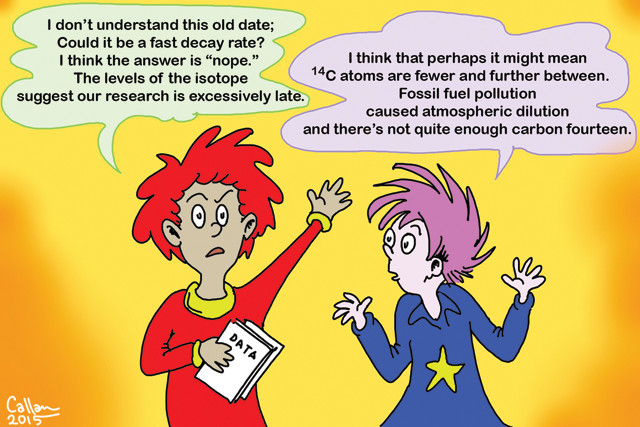
by Allison Mills Friday, October 23, 2015

Credit: Callan Bentley.
Radioactive carbon-14, or radiocarbon, is used to date fossils and artifacts and study ecosystems, as well as to solve crimes and run medical tests. But these applications could be in jeopardy, according to new research illustrating how atmospheric radiocarbon will be diluted by fossil fuel emissions in the coming century.
“Given current emission trends, fossil fuel-driven artificial ‘aging’ of the atmosphere is likely to occur much faster and with a larger magnitude than previously expected,” wrote Heather Graven, a physicist at Imperial College London, in a study published in Proceedings of the National Academy of Sciences.
Radiocarbon is the Swiss Army Knife of the chemistry world: It’s common and useful in many ways. With a half-life of 5,700 years, it has become the standard for dating artifacts and biological samples up to about 50,000 years old. Formed naturally in Earth’s atmosphere, primarily through conversion of nitrogen by high-energy cosmic rays, radiocarbon is incorporated into biological materials the same way abundant nonradioactive carbon-12 is. Over time the radiocarbon decays, leaving these materials with less and less and offering scientists a means to date samples of the materials — as long as the starting concentration in the atmosphere is known.
Natural carbon cycles cause some fluctuations in the proportion of carbon-14 relative to total atmospheric carbon, but this ratio has been relatively constant over the long term. In the past couple of centuries, however, radiocarbon levels in the atmosphere have been impacted by human activity. Since the start of the Industrial Revolution, carbon stored in coal, oil and gas — materials that are old enough so that the carbon-14 originally in them decayed long ago — has increasingly made its way into the atmosphere. This lowers the natural ratios of the heavy carbon isotopes, carbon-13 and -14, to total carbon through dilution, a phenomenon called the Suess Effect, first noted in 1955. With proportionately less radiocarbon in the air, materials absorbing atmospheric carbon would appear artificially older than they actually are when dated using radiocarbon. This dilution was briefly reversed with the initiation of nuclear weapons testing in the mid-20th century, which released man-made radiocarbon into the skies; the carbon-14 spike made for a useful marker for scientists dating samples from the past century. However, fossil fuel emissions are overtaking that pulse of “bomb” radiocarbon and beginning to deplete the atmosphere once more.
“We’re getting close to the pre-industrial level [of radiocarbon], and it looks like within the next 50 years we’ll drop below that level — that’s when the atmosphere will start to look depleted,” Graven says, explaining that the exact extent of dilution will depend on future emissions.
To predict what will happen to radiocarbon levels in the coming decades, Graven modeled the global carbon cycle through 2100, using the projected carbon emission scenarios assembled in the latest Intergovernmental Panel on Climate Change’s assessment report. Her modeling confirmed that fossil fuel emissions will be the main driver of impacts on radiocarbon. Graven says that by 2050, under the “business-as-usual” scenario that assumes current emissions trends won’t change dramatically in the future, scientists using radiocarbon dating won’t be able to distinguish between the ages of a modern T-shirt and a robe worn by William the Conqueror a millennium ago, because of the atmospheric aging related to radiocarbon dilution.
Ken Caldeira, an atmospheric scientist studying global ecology at the Carnegie Institution for Science in Stanford, Calif., says he’s not surprised by Graven’s results — in fact, he made similar predictions two decades ago.
It is “heartwarming” in a way, he says, to see his own model predictions later confirmed. While that confirmation is nice, the outcomes in the real world are not, Caldeira says. “Adding all of this ancient carbon to the atmosphere is making the atmosphere look old from a radiocarbon perspective, which will have obvious implications for future efforts to use radiocarbon to date samples,” he says. And radiocarbon is used not just for dating artifacts, but also for assessing cell regeneration in neurological medicine as well as for spotting forged art and illegally traded ivory.
Graven points out that each application could be affected differently. She says that with carbon emission projections escalating, more work could be done to improve radiocarbon measurement sensitivity to better detect diluted carbon-14 and develop a clearer understanding of localized impacts of the Suess Effect.
© 2008-2021. All rights reserved. Any copying, redistribution or retransmission of any of the contents of this service without the expressed written permission of the American Geosciences Institute is expressly prohibited. Click here for all copyright requests.